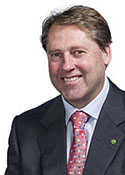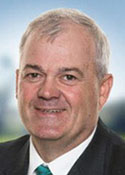O’Connor
Margin: Liberal 1.0% versus Nationals
Region: Southern Regional, Western Australia
In a nutshell: The Liberals have assumed a secure hold on the northern Western Australian seat of Durack amid a picture of long-term regional decline for Labor.
Candidates in ballot paper order

|
RICK WILSON JOHN HASSELL TREVOR YOUNG JON FORD STEPHEN CARSON GIZ WATSON |
The electorate of O’Connor covers rural and remote areas in the south of Western Australia, the major population centres being the historic gold rush city of Kalgoorlie and Albany on the south coast. It also accommodates the southern part of the Wheatbelt, the declining logging region around Manjimup, and vast remote territories in the east. The new redistribution proposes the addition of 6000 voters around the south-western coal and electricity town of Collie from Forrest, and the removal of about 3000 voters at the interior end of the Wheatbelt to Durack. Collie is an area of strength for Labor, and its inclusion has cut the Liberal margin versus Labor from 17.2% to 14.9%.
O’Connor was created at the 1980 election, prior to which Albany and the remainder of the Great Southern region was in Forrest, while the remainder was in Kalgoorlie. It has been held by the Liberals for all but one term, the exception being after the 2010 election, when the Western Australian Nationals had their first and thus far final win in a House of Representatives seat since 1974. That result put an end to the 30-year career of Liberal firebrand Wilson Tuckey, who owed his “Ironbar” nickname to an assault conviction over an incident involving a length of steel cable and an Aboriginal patron of his Carnarvon hotel.
Tuckey was then seeking re-election at the age of 75, and had come to be regarded in Canberra as an increasingly erratic figure. His position had been further weakened when the state’s regional areas were fundamentally rearranged by a redistribution, which saw O’Connor exchange the northern half of the Wheatbelt for Esperance and the Goldfields. The Nationals candidate, Tony Crook, was able to overcome a 38.4% to 28.9% deficit against Tuckey on the primary vote to prevail by a 3.6% margin after preferences. Tuckey reacted to his defeat by saying he did “not intend to be gracious at all”, and dismissed Crook, who had been chairman of the Royal Flying Doctor Service, as a “nobody”.
Crook’s win situated him as a non-aligned member in a hung parliament, the WA Nationals having campaigned as an independent party that would not “report, answer and take direction from Warren Truss”. However, few were surprised when, after a fortnight of prevarication, he announced he would support the Coalition on confidence and supply. Crook announced his decision not to seek a second term in April 2013, complaining of the demands of travel from Western Australia to Canberra and his desire to spend more time with his family. The seat then drifted back to the Liberal fold at the 2013 election, at which the party’s candidate, Katanning farmer Rick Wilson, prevailed over William “Chub” Witham of the Nationals by a margin of 1.0%. Wilson was public in his support for Tony Abbott during the September 2015 leadership challenge.
O’Connor will be contested for the Nationals by John Hassell, a Pingelly grain farmer and director of grain export co-operative CBH Group; for Labor by Jon Ford, a state upper house MP from 2001 to 2013 and minister in the Gallop/Carpenter government; and for the Greens by Giz Watson, who was the leading figure in the state parliamentary party from 1997 to 2013, when she unsuccessfully attempted to move upper house regions from North Metropolitan to South West.
Analysis by William Bowe. Read William’s blog, The Poll Bludger.


